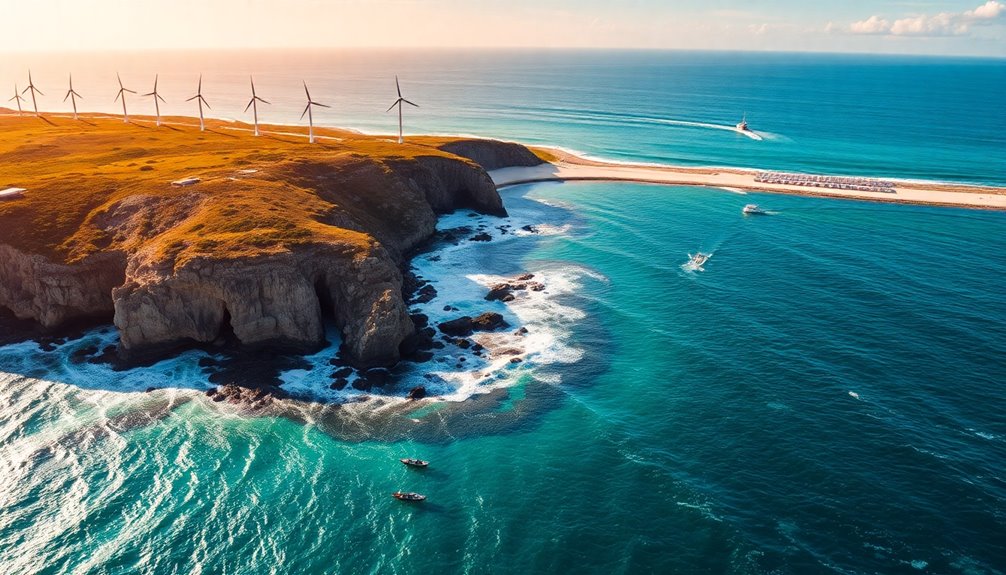If you're looking for prime ocean energy sites around the world, consider Florida's East Coast and South Africa's coast, both showing high energy densities ideal for turbines. The Southeastern U.S. and Eastern Africa also offer favorable conditions for energy extraction. These areas boast power densities that could exceed 2,500 watts per square meter, pointing to vast renewable potential. Keep exploring to uncover even more promising locations and the challenges they face in harnessing ocean energy.
Key Takeaways
- Florida's East Coast boasts high power densities, making it ideal for ocean energy turbine installations.
- The South African coast shows significant potential for energy extraction due to favorable conditions.
- The Southeastern U.S. from Florida to North Carolina has remarkable energy densities for ocean energy generation.
- Eastern Africa, including Somalia, Kenya, and Tanzania, presents promising opportunities for ocean energy utilization.
- Approximately 490,000 square kilometers of ocean across these regions offer enhanced energy generation potential.

As the world's electricity demand continues to rise, tapping into ocean energy has never been more critical. With over 70% of the Earth's surface covered by oceans, the potential for renewable energy from tidal streams, waves, and ocean currents is immense. As traditional energy sources face increasing strain, ocean energy presents a promising alternative that you can't overlook.
Tapping into ocean energy is essential for meeting rising electricity demand and offers immense renewable potential.
Recent studies have identified prime locations for harnessing ocean current energy. For instance, Florida's East Coast stands out with its consistently high power densities, making it an ideal spot for ocean current turbines. Similarly, the South African coast showcases significant potential, and the southeastern U.S. region from Florida to North Carolina offers remarkable energy densities.
Eastern Africa, particularly countries such as Somalia, Kenya, Tanzania, and Madagascar, also boasts favorable conditions for energy extraction. Approximately 490,000 square kilometers of ocean exhibit high power densities, which enhances the potential for energy generation in these regions.
You might be surprised to learn that areas like Florida and South Africa can deliver power densities exceeding 2,500 watts per square meter. These shallow waters enhance the feasibility of energy extraction, while deeper regions pose technical challenges that require advanced technology for turbine installation and maintenance. The energy density of ocean currents can be 2.5 times greater than that of excellent wind resources, showcasing the untapped potential in these waters.
However, challenges remain. Limited data in regions like Brazil and South Africa complicates accurate energy assessments. Complex flow patterns in deeper waters further increase extraction difficulties. Seasonal variations can affect energy availability, which may not always align with demand. High costs associated with deep-water installations also make feasibility a concern.
Despite these hurdles, countries like China and those in Europe are leading the charge in ocean energy advancements. The U.S. is investing significantly in marine energy research, supporting the growth of this promising sector.
As you explore the potential of ocean energy, these prime sites reveal a pathway toward a more sustainable energy future.
Frequently Asked Questions
What Are the Environmental Impacts of Ocean Energy Sites?
Ocean energy sites can significantly impact marine ecosystems.
You'll notice alterations in chemical and physical conditions, which may disturb biodiversity. Noise pollution from installation can disrupt marine mammals, while habitat changes can affect local tourism.
Additionally, energy installations might disrupt migration patterns and feeding behaviors of marine life.
To mitigate these effects, careful site selection and thorough environmental assessments are crucial for preserving the delicate balance between energy production and ecosystem health.
How Do Ocean Energy Technologies Work?
Ocean energy technologies harness power through various methods.
You might see wave energy converters capturing kinetic energy from waves, while tidal systems utilize the movement of tides to generate electricity.
Offshore wind turbines work similarly to land-based ones, positioned in coastal waters.
Ocean Thermal Energy Conversion (OTEC) exploits temperature differences in the water.
Each method converts natural ocean energy into electricity, providing a renewable source that can help meet energy demands sustainably.
What Is the Cost of Developing Ocean Energy Projects?
When you dive into the costs of developing ocean energy projects, you'll find a wide range.
Wave energy typically sits between $120 and $470 per MWh, while tidal energy falls between $130 and $280.
Though these numbers seem high, expect significant reductions as technology advances.
The infrastructure challenges are real, but as you explore more, you'll see that investment and innovation could lead to a more sustainable and affordable future in ocean energy.
Are There Any Safety Concerns With Ocean Energy?
Yes, there are safety concerns with ocean energy.
You should be aware of potential impacts on marine habitats and species, like those from tidal and wave energy installations.
Noise pollution can disturb marine mammals, while electromagnetic fields from cables might affect marine life.
Additionally, there's a risk of collisions with devices, and biofouling can complicate equipment.
It's crucial to consider these factors when exploring ocean energy options for sustainability.
How Do Ocean Energy Sites Affect Marine Life?
Isn't it ironic that while you harness ocean energy to save the planet, marine life may be paying the price?
Ocean energy sites disrupt habitats, alter hydrodynamics, and create noise pollution, all of which can displace marine species.
You might think such installations promote biodiversity, but they can also lead to habitat loss and behavioral changes in animals.
Balancing energy needs with marine conservation is crucial, and monitoring these impacts is essential for sustainable development.
Conclusion
As we sail into the future, the ocean's energy potential beckons like a siren's song, urging us to harness its currents and waves. These prime sites are not just locations; they're gateways to a sustainable tomorrow. By embracing this boundless power, we can ride the tides of change and illuminate our world. Let's dive in and explore the depths of opportunity, ensuring that the waves we create today ripple into a cleaner, greener future for generations to come.









